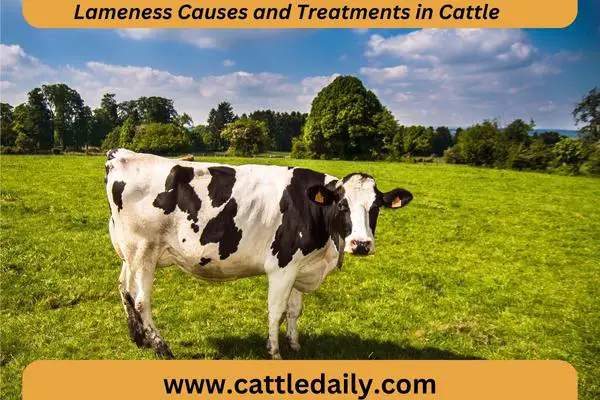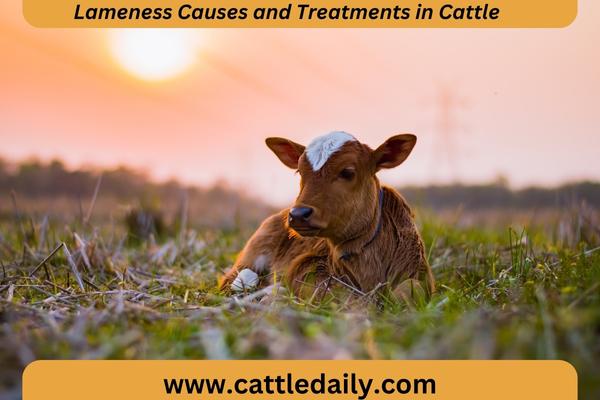Lameness Causes and Treatments in Cattle
Lameness is one of the most prevalent and costly diseases affecting the welfare and productivity of dairy and beef cattle worldwide. It is estimated that lameness affects up to 20% of UK dairy cows every year.
Not only does lameness negatively impact cow health and milk production, but it also leads to significant economic losses for cattle farmers through reduced fertility, increased culling, slower growth rates, and the costs of treatment.
In this blog post, we will cover the main causes of lameness in cattle, outlines preventative measures farmers can implement on their farms, and detail the various treatment options available.
What Causes Lameness in Cattle?
Lameness in cattle has a variety of potential causes which can broadly be divided into infectious causes, environmental/management factors, and physical trauma. The most common specific causes include:
1. Foot Rot
Foot rot is one of the leading infectious causes of lameness in cattle globally. This highly contagious bacterial infection affects the area between the claws of the hoof, causing swelling, dead tissue, foul-smelling discharge, and ultimately, lameness.
2. Digital Dermatitis
Also known as hairy heel wart, digital dermatitis is another highly infectious cause of cattle lameness. This disease presents as a raw, ulcer-like lesion usually near the coronary band. The lesions are very painful and cause severe lameness if left untreated.
3. Sole Ulcers and White Line Disease
Both sole ulcers (also called Rusterholtz ulcers) and white line disease affect the internal structures of the hoof and can cause sudden onset severe lameness.
White line disease is thought to occur due to abnormal horn growth of the hoof wall weakening it and allowing infection to enter.
4. Laminitis
Laminitis is inflammation of the sensitive laminae of the hoof that connects the pedal bone to the hoof wall. This painful condition can be caused by diet, toxins, high genetic merit cows transitioning into lactation, and systemic infection.
Laminitis results in abnormal, slow hoof horn growth and rotation/displacement of the pedal bone resulting in lameness.
5. Environmental Factors
Issues with cow tracks, overstocking leading to increased contact with slurry and concrete floors with poor grip increasing the risk of slips and falls can all lead to lameness. Poor foot hygiene from standing in slurry or muddy fields also compromises hoof horn quality and predisposes to hoof infections.
6. Injuries
Physical damage to structures of the hoof either from trauma/wounds or abnormal, asymmetric hoof wear can result in lameness. Leg injuries such as fractures, dislocations, and ligament/tendon strains are also costly causes of lameness in cattle.
7. Hoof Trimming Issues
Poor hoof trimming techniques that don’t follow the natural angles of the bovine hoof can significantly alter weight distribution increasing lameness risk.
Likewise, leaving the hoof too long or too short, uneven wear and damage from tools can all trigger lameness episodes.

Lameness Prevention Strategies
As the old adage goes “prevention is better than cure” and this applies as much to bovine lameness as any other cattle disease.
Whilst not all cases can be avoided, farmers can implement a range of prevention strategies to reduce lameness incidence and safeguard cow welfare and farm profits.
Effective prevention measures include:
- Appropriate nutrition and body condition score maintenance especially for high-yielding, early lactation cows.
- Comfortable, clean housing and bedding to avoid slips and trauma.
- Regular hoof trimming every 6-12 months using proper technique to maintain normal anatomy avoiding uneven, excessive wear.
- Routine foot baths for high-risk groups when the infection is detected using zinc sulfate or copper sulfate solutions.
- Segregation, prompt treatment, and culling of persistently infected carrier cows spreading contagious pathogens.
- Quarantine and screening incoming cattle purchases for digital dermatitis, foot rot, and other infectious causes of lameness.
- Limiting concrete walkway distance and using grooved concrete to improve grip reducing risk of injuries.
- Avoid overstocking and maintaining dry cow tracks free of sharp stones to prevent foot trauma.
- Optional use of vaccines against digital dermatitis and foot rot pathogens to reduce infection severity and transmission between animals.

Treating Lameness
The first step when presented with a lame cow is to determine the affected limb and then conduct a thorough clinical exam including lifting the foot to help locate the exact painful structure.
If the cause of lameness isn’t immediately obvious, further diagnostics such as nerve blocks, hoof trimming, radiographs, or bone scans might be required.
Once the underlying issue is identified, an appropriate treatment plan can be formulated which may include:
- Non-steroidal anti-inflammatories (NSAIDs) to relieve pain and inflammation. Meloxicam injections typically provide longer-lasting pain relief than oral NSAIDs like Flunixin meglumine.
- Antimicrobial therapy if an infection is suspected either systemic, topical or both are options depending on diagnosis.
- Aggressive hoof trimming to remove diseased hoof horn and improve weight distribution across the foot. Must be done under adequate nerve blocks.
- Foot bathing using 5% copper or 10% zinc sulfate solutions are very useful for infectious causes of lameness but feet may require pre-soaking for 10-20 minutes if much swelling or discharge is present initially.
- Hoof bandages & blocks provide support to damaged hooves enabling them to regenerate new healthy hoof horns.
- Lesion debridement surgical or chemical removal of diseased tissue allows antibiotics better penetration to clear infection in conditions like digital dermatitis.
- Soft deep bedding, hospital pens, and non-slip surfaces help lame cows mobilize comfortably without worsening the condition.
- Judicious culling decisions if lameness is non-responsive to treatment or persists longer than 6 months.
In conclusion, lameness remains an extremely prevalent and important disease that reduces cattle health, welfare, and farm profitability worldwide.
By focusing efforts on prevention and early intervention when cases do occur farmers can help safeguard their herds and businesses from the negative impacts of lameness.
Taking a proactive team approach with a veterinarian that combines management changes, prompt cow side treatment, and selective culling is key for successfully combatting lameness long-term.


